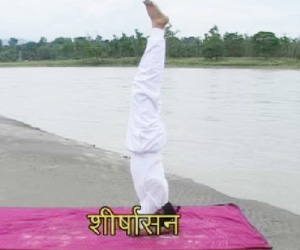Sirsasana | Headstand Pose
Sirsa in Sanskrit means head and this asana cures all diseases. This is one of the tough asanas.
Process
1. Start with a folded blanket to put the head and forearms on it
2. Kneel on the ground and put the fingers together, keep the forearms on the ground.
3. Place the blanket between the palms.
4. Open the hands to place the head into open palms.
5. Move the feet carefully closer to the elbows, heels elevated.
6. Exhale to lift the one feet from the ground, then lift other feet from the ground and try to keep them straight. After practicing some time both feet can be lifted simultaneously.
7. Keep legs, thighs, knees perpendicular to the ground
8. Put the weight equally balanced on two forearms
9. Stay there for few seconds, breathe normally.
10. Come down with exhaling ,let the both feet touch the ground at the same time and relax in shavasana for a few minutes to normalize the blood circulation
Duration
Start with a stay for few second and add five to ten second every day to extend it up to three minutes. Do it for a week or two and extend it up to five minutes gradually.
Benefits
- Brain calms down , relieve stress and mild depression.
- Stimulates pituitary and pineal glands.
- Strengthens arms, legs, and spine.
- Tones up abdominal organs and digestion improves.
- Relieve the symptoms of menopause .
- Improves functioning of thyroid gland.
Precautions
- Avoid it if suffering from back injuries.
- Don’t do it in headache.
- Patients with heart or blood pressure problems should avoid it.
- Start this asana under the supervision of an experienced person.
- Beginner should take the support of wall to rest their legs on because it is difficult for some person to raise legs upwards.
- Breathe normally and don’t hold breath while standing on head.
